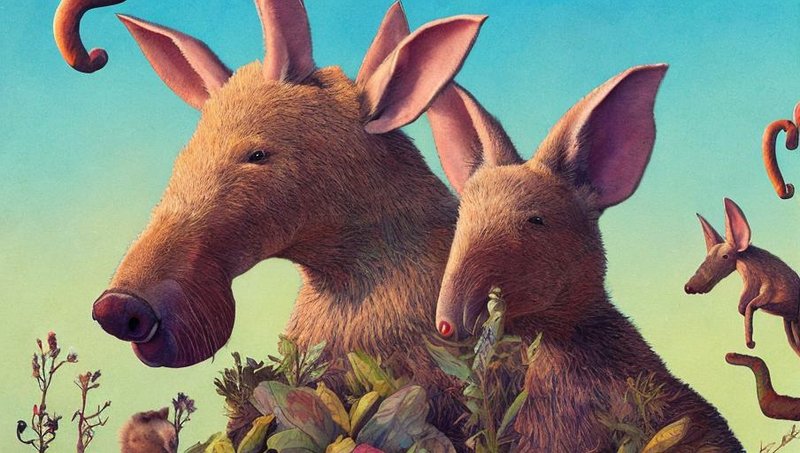
Imagine sitting across from a friend over coffee as they share stories about wild animals. You might hear tales of lions and elephants, but when it comes to the aardvark, those stories often miss the mark. Perhaps you’ve heard that they’re related to pigs or that they only live in Africa. Let’s dive into the common myths surrounding aardvarks and uncover the truth behind these intriguing creatures.
Aardvarks Are Related to Ants
One of the most persistent misconceptions is that aardvarks are closely related to ants. Sure, they eat ants, but that doesn’t mean they’re family! Aardvarks belong to their own order called *Tubulidentata*, which is quite distinct from the insect world.
You might be wondering why people connect aardvarks to ants. It all boils down to their diet. Aardvarks primarily feast on ants and termites, using their long, sticky tongues to snag these insects. This has led many to assume they must be in the same family. However, aardvarks are more closely related to elephants and manatees than they are to ants. Isn’t that wild?
So, the next time you hear someone claim that aardvarks are just giant ants, you can confidently correct them. They’re unique creatures, doing their own thing in the grand tapestry of wildlife.
Aardvarks Are Blind
Another common myth is that aardvarks are blind. This misconception likely stems from their nocturnal lifestyle and their unusual appearance, which can make them look a bit silly. But here’s the thing: aardvarks actually have good eyesight!
While they primarily rely on their sense of smell and hearing to navigate and find food in the dark, they can see quite well. Their large ears help them pick up sounds, and their keen nose leads them to tasty treats underground. So, while they may not be the best at spotting a predator from far away, they certainly aren’t stumbling around blind.
It’s interesting how our perceptions can shape our understanding of an animal. Just because an aardvark looks a bit clumsy doesn’t mean it lacks the necessary senses to survive in its environment.
Aardvarks Only Live in Africa
You may have heard that aardvarks are native only to Africa, and while that’s mostly true, there are nuances. Aardvarks are indeed found throughout sub-Saharan Africa, but their range isn’t just limited to one country or type of environment. They thrive in a variety of habitats, from savannas to grasslands.
However, there’s an intriguing twist to their limited distribution. Aardvarks have adapted to various climates and conditions across Africa, but they haven’t made a home anywhere else in the wild. This has led to a misconception that if you ever see one outside of Africa, it must be in a zoo. While that’s true for the most part, the reality is that their specialized needs make them less suited for life in other areas.
So, if you’re ever traveling in Africa, keep your eyes peeled! You might just spot an aardvark roaming around under the cover of night.
Aardvarks Are Just Veggies and Bugs
While it’s true that aardvarks primarily consume ants and termites, this leads to a common misunderstanding about their diet. Some folks believe that they only eat insects. But let me explain: aardvarks also enjoy a variety of fruits, especially when the opportunity arises.
In the wild, they’ll munch on the fruit of the aardvark cucumber (yes, that’s a real thing!) and other juicy snacks. This is especially true during dry seasons when insects are less abundant. So, calling them strictly “bug-eaters” doesn’t capture the full picture.
In essence, aardvarks are opportunistic feeders. They take advantage of whatever food source is available, which can include both insects and plants. Their flexible diet is a testament to their ability to adapt to changing environments.
Aardvarks Are Dangerous
Have you ever heard someone say that aardvarks are dangerous animals? You might picture a fierce creature ready to attack if threatened. The truth? Aardvarks are generally shy and solitary. They’d much rather avoid confrontation than engage.
Aardvarks have sharp claws that they use for digging, but they’re not seeking out fights. When threatened, they typically rely on their speed and ability to dig quickly to escape rather than confront danger head-on. Interestingly, they can dig a burrow in seconds, which serves as a quick escape route when faced with a predator.
So if you encounter an aardvark in the wild, don’t panic! They’re not out for blood; they simply want to be left alone to live their quiet, nocturnal lives.
Aardvarks Are Slow and Clumsy
You might picture an aardvark as a slow-moving creature that lumbers along in a comical way. While they do have a unique gait, they are surprisingly fast when they need to be. Their body may look a bit awkward, but they can run at impressive speeds to evade danger.
The idea that they are clumsy likely comes from their large ears and long snouts, which can make them seem a bit silly. But their design is perfectly suited for their lifestyle, allowing them to navigate through dense brush and dig effortlessly in search of food.
In fact, their digging prowess is a critical survival skill. They can create complex burrow systems that not only shelter them from predators but also serve as homes for a variety of other animals. So next time you think of aardvarks as sluggish, remember that they have their own rhythm and grace—just in a way that’s unique to them.
Aardvarks are often misunderstood creatures, and it’s easy to see why. With their unusual looks and unique habits, they can become the subjects of myths and misconceptions. By breaking down these common assumptions, we gain a deeper appreciation for these fascinating animals and their important roles in the ecosystem.
Understanding the truth about aardvarks helps us foster a sense of curiosity and respect for wildlife. The next time you hear a myth about them, feel confident in correcting your friends or sharing the facts. After all, there’s so much more to aardvarks than meets the eye!

